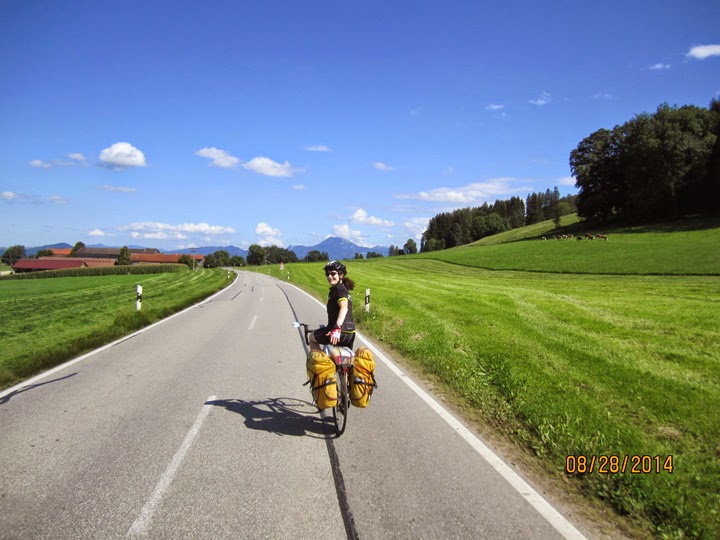Saturday, August 30 was a non-biking day, which we spent as
"regular" tourists hosted by an old friend Karl-Heinz Lumpi and a new
friend Brigitte Lumpi (Karl's wife). They took us to the town of Hallstatt,
home of the world's oldest salt mine, which began operations 7000 years ago.
The four of us went on a guided tour of the mine, which was both educational and
fun. The tour includes information provided by the guide as well as via a
number of brief movies. Together, these explain how the salt-containing
mountains formed (partly as a result of continental drift), how the early residents
of the area came to realize that there was salt to be mined, and how the
technologies have evolved over time to extract the salt. The tour also includes
two long, steep, wooden slides that provide exhilarating rides down into the
depths of the mine. An interesting fact about salt is that the word salary
originates from the Latin word "salarium", which referred to the
money paid to the Roman Army's soldiers as an allowance to buy salt, a valuable
substance since salting was an important method of food preservation.
We also toured the picturesque town of Hallstatt (so
picturesque, in fact, that a full-size version of the town has been replicated
in China). An attraction in the town is the Beinhaus -- bone house -- that
dates back to the twelfth century and contains over 1200 skulls neatly stacked
in rows along with next of kin. Since the town's cemetery is so small, without room
to expand, graves were opened 10 - 15 years after burial and the skulls were
removed (sometimes with other bones). The skull was cleaned and exposed to the
sun and moon light for weeks until they were bleached ivory white, and then
placed in the Beinhaus. The last skull placed into the Beinhaus was in 1995.
Our day ended with a marvelous dinner with the Lumpi's, together
with Omar Ishrak (CEO and president of GE Healthcare until 2011, currently Chairman
and CEO of the medical technology company Medtronics). We were also joined by
the Lumpi's son Daniel and his wife and 8-month-old baby. The food and company
were wonderful.
Today's bike ride was intended to be a 64-mile ride to
Mauthausen, Austria. The town has a gruesome history, since the Mauthausen-Gusen
concentration camp was a group of camps built around Mauthausen, located 12
miles east of Linz on the Danube River. Mauthausen became the largest labor
camp in Nazi-held territory during World War II and had a reputation for being
the toughest, with its goal of exterminating inmates through hard labor.
Inmates worked in quarries and factories on a starvation diet of less than 1000
calories per day. Weak, emaciated prisoners were forced to carry heavy stones
up steep stairs at the quarry. If one fell backwards, a series of prisoners
would be carried down with the fall, like an avalanche. Besides deaths from
these dangerous work conditions, prisoners were killed from beatings, ice
showers, shootings, medical experiments, electrical shock, and, later, a gas
chamber built at the camp. The
Mauthausen camp was the last of the concentration camps to be liberated. By the
time the Allies came, approximately 240,000 of the 320,000 prisoners had died.
One of the survivors of this camp was Simon Wiesenthal, an engineer who has devoted
his life to hunting Nazi war criminals.
When we arrived at Mauthausen and went to the guesthouse
we'd booked, we immediately had bad vibes about it. Laundry and shoes were blocking
the hallway, rooms were tiny, and WiFi was spotty. Contributing to our aversion
to the Mathausen guesthouse was the horrible history of the town, which we had
read about at breakfast this morning before hopping on our bikes. We left Mauthausen and biked back 4 miles to
stay at a hotel in the adjoining town Enns.
 |
| With the Karl-Heinz and Brigitte Lumpi, dressed in what looks like prison garb. It's what's provided to wear during the tour of the Hallstatt salt mine. |
 |
| Hurtling down into the mine |
 |
| Town square in Hallstatt |
 |
| Some of the 1200 skulls, together with femurs and humeri, in the Beinhaus Scenes from our ride today: |
 |
| Crossing the Danube |
 |
| They apparently have some pretty strict rules in Austria. [Actually, "Windpassing" is the name of a town.] |











































